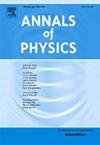Quantum dynamics of curves on curved surfaces embedded in Euclidean space
IF 3
3区 物理与天体物理
Q2 PHYSICS, MULTIDISCIPLINARY
引用次数: 0
Abstract
Fabrication of one-dimensional curved waveguide on two-dimensional curved manifold may give an impetus to the investigation on new devices. Understanding how the combined geometric quantities of the curve and surface affect the quantum dynamics calls for an effective theory. Here, we delve into the effective Hamiltonian governing a quantum particle confined to a curve that lies on a curved surface. By categorizing the constraints, we derive the effective Hamiltonians for two distinct scenarios: one where the curve is encapsulated in the surface, and another where the curve is a narrow ridge on the surface. The surface’s geometry substantially influences the dynamics of the curve, with the gauge potential in the former case being proportional to the geodesic torsion, and the emerging surface geodesic potential in the latter case being determined by both the geodesic curvature and geodesic torsion. We apply both the Hamiltonians to model quantum dynamics in circles on a sphere and helices on a cylinder, analyzing how the effective potential varies with different geometric parameters. This research serves as a foundational reference for the design of future waveguides, offering insights into how to manipulate quantum states within curved nanostructures.
嵌入欧几里德空间的曲面上曲线的量子动力学
在二维曲面流形上制作一维曲面波导,可以推动新器件的研究。理解曲线和曲面的组合几何量如何影响量子动力学需要一个有效的理论。在这里,我们深入研究受控于曲线上的量子粒子的有效哈密顿量。通过对约束进行分类,我们导出了两种不同情况下的有效哈密顿量:一种情况下曲线被封装在曲面中,另一种情况下曲线是曲面上的窄脊。曲面的几何形状在很大程度上影响了曲线的动力学,前者的规范势与测地线扭转成正比,后者的新兴曲面测地线势由测地线曲率和测地线扭转共同决定。我们应用这两种哈密顿量分别模拟了球上的圆和圆柱上的螺旋的量子动力学,分析了有效势随不同几何参数的变化情况。这项研究为未来波导的设计提供了基础参考,为如何在弯曲纳米结构中操纵量子态提供了见解。
本文章由计算机程序翻译,如有差异,请以英文原文为准。
求助全文
约1分钟内获得全文
求助全文
来源期刊

Annals of Physics
物理-物理:综合
CiteScore
5.30
自引率
3.30%
发文量
211
审稿时长
47 days
期刊介绍:
Annals of Physics presents original work in all areas of basic theoretic physics research. Ideas are developed and fully explored, and thorough treatment is given to first principles and ultimate applications. Annals of Physics emphasizes clarity and intelligibility in the articles it publishes, thus making them as accessible as possible. Readers familiar with recent developments in the field are provided with sufficient detail and background to follow the arguments and understand their significance.
The Editors of the journal cover all fields of theoretical physics. Articles published in the journal are typically longer than 20 pages.
 求助内容:
求助内容: 应助结果提醒方式:
应助结果提醒方式:


